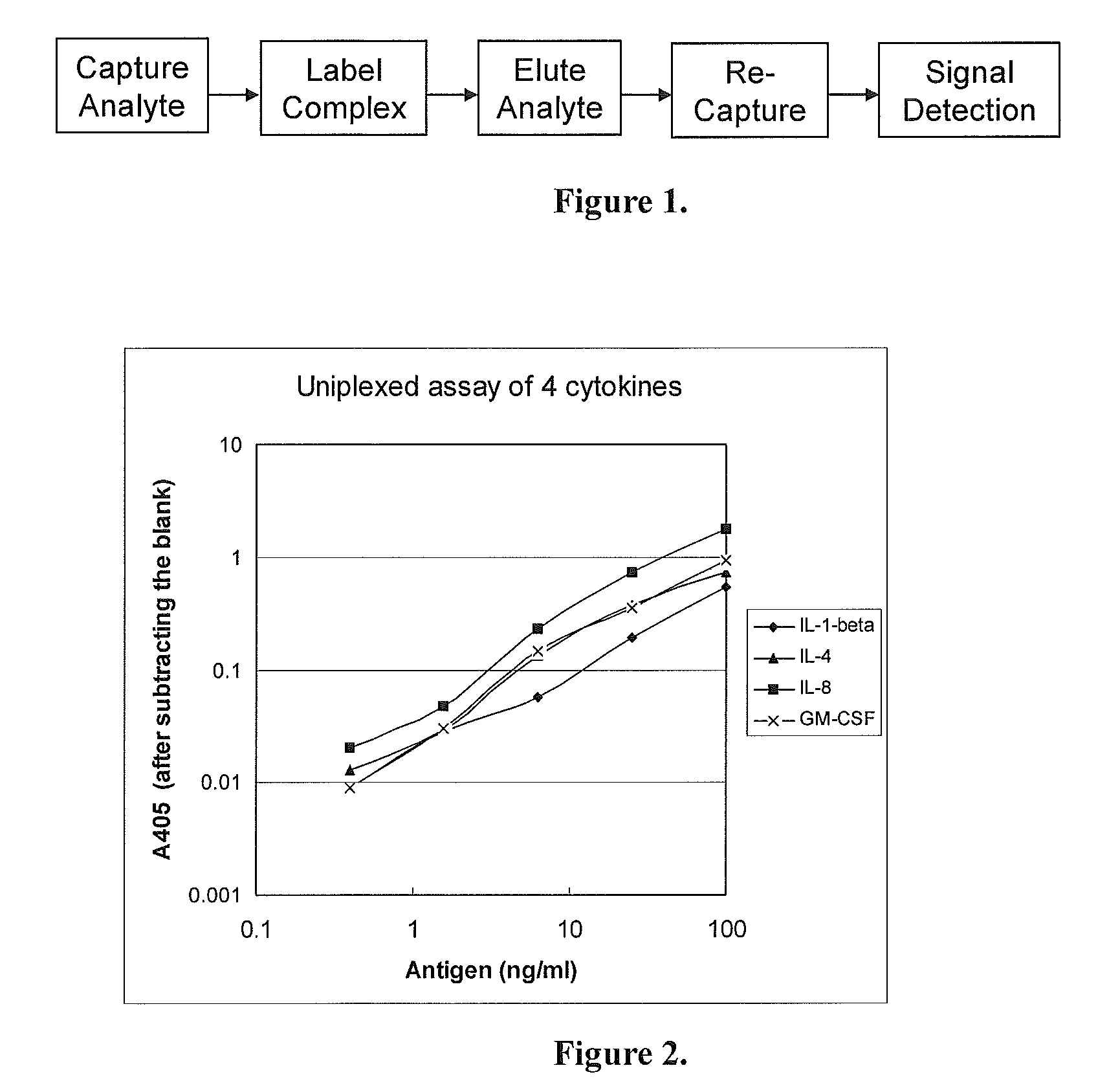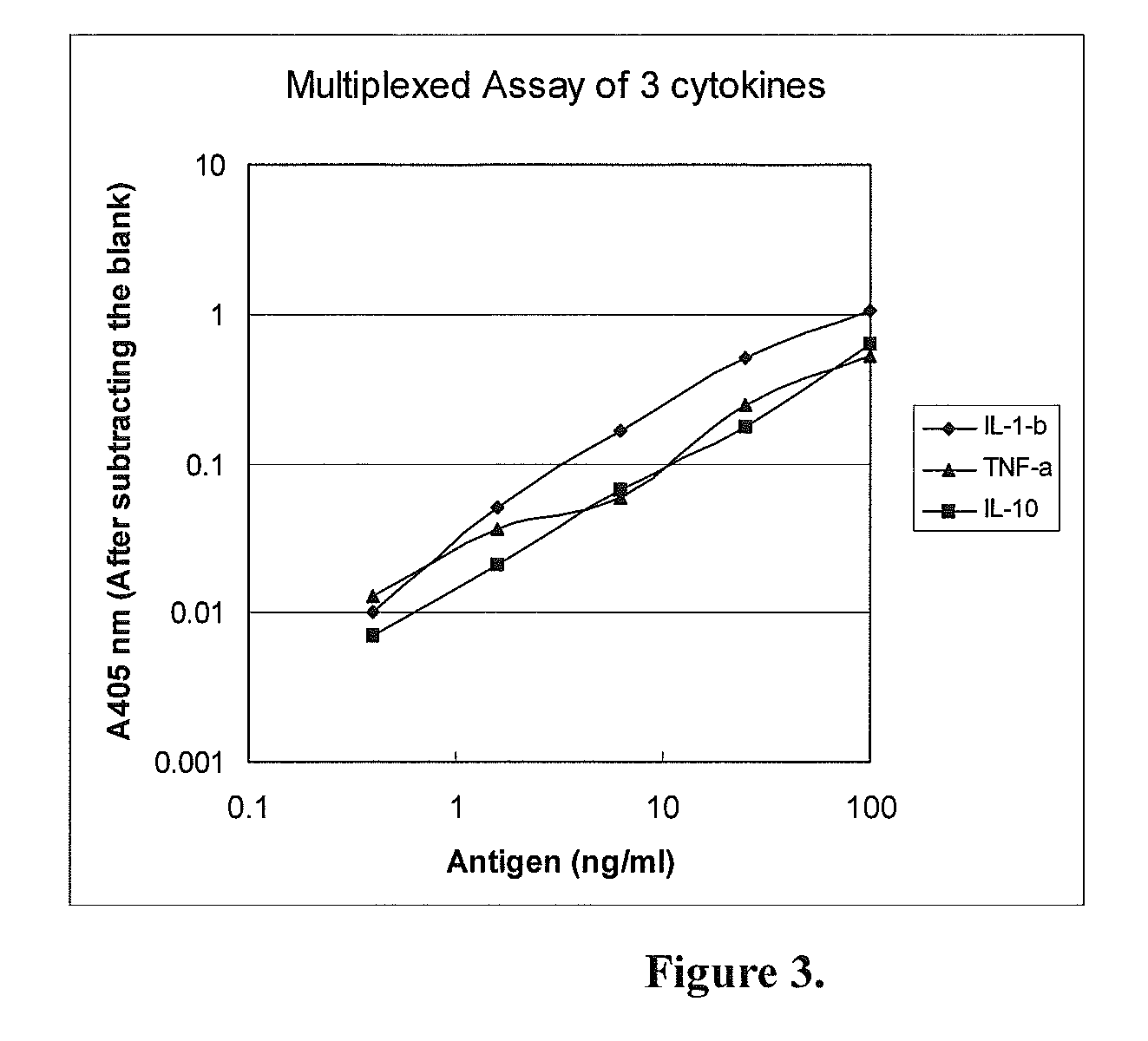Method and its kit for quantitatively detecting specific analyte with single capturing agent
a technology of specific analyte and kit, applied in the field of biotechnology, can solve the problems of limited broader application of sandwich elisa, usually takes a great effort and a long time to develop such antibody pairs against the same analyte, and achieves low background noise, high specificity, and reduced background noise
- Summary
- Abstract
- Description
- Claims
- Application Information
AI Technical Summary
Benefits of technology
Problems solved by technology
Method used
Image
Examples
specific example 1
Uniplexed Assay (Detecting One Protein)
[0037]In this Specific Example, the Capture Device and the Detection Device were both made of 96-well microtiter plates. The Capture Device was coated with a single antibody for detecting one antigen. The analytes were 4 human cytokines: IL-1-beta, IL-4, IL-8 and GM-CSF. Their corresponding antibodies were all monoclonal antibodies from Biolegend, USA).
[0038](1) Capturing the Antigens
[0039]a. Coating with the capture antibodies: Two 96-well microtiter plates (flat-bottom, with high binding capacity to proteins) were used, one (the Capture Device) for capturing the antigens in samples, and the other (the Detection Device) for detecting the labeled antigens. To each well, 100 μl of a capture monoclonal antibody at 0.5 μg / ml (diluted in phosphate-buffered saline, PBS) was added. On each plate, 8 wells were coated with each of the monoclonal antibodies against IL-1-beta, IL-4, IL-8 and GM-CSF. The plates were incubated at 4° C. overnight.
[0040]b. B...
specific example 2
Multiplexed Assay (Detecting Three Proteins Simultaneously)
[0051]In this specific example, the Capture Device and the Detection Device were both made of a 96-well microtiter plates. The Capture Device was coated with a mixture of three antibodies for detection of three antigens simultaneously. The analytes to be tested were 3 human cytokines: IL-1-beta, TNF-alpha and IL-10. Their corresponding antibodies were all monoclonal antibodies.
[0052](1) Capturing the Antigens
[0053]a. Coating with the capture antibodies: Two 96-well microtiter plates (flat-bottom, with high binding capacity to proteins) were used, one for capturing the antigen (the Capture Device) and another for detecting the signal (the Detection Device). The wells in the Capture Device were coated with 100 μl of a mixture of the 3 monoclonal antibodies against human IL-1-beta, TNF-alpha and IL-10, each at 0.5 μg / ml (in PBS). Eight wells were coated. The wells of the Detection Device were separately coated with just one of ...
PUM
| Property | Measurement | Unit |
|---|---|---|
| concentrations | aaaaa | aaaaa |
| subcellular structure | aaaaa | aaaaa |
| fluorescent | aaaaa | aaaaa |
Abstract
Description
Claims
Application Information
 Login to View More
Login to View More - R&D
- Intellectual Property
- Life Sciences
- Materials
- Tech Scout
- Unparalleled Data Quality
- Higher Quality Content
- 60% Fewer Hallucinations
Browse by: Latest US Patents, China's latest patents, Technical Efficacy Thesaurus, Application Domain, Technology Topic, Popular Technical Reports.
© 2025 PatSnap. All rights reserved.Legal|Privacy policy|Modern Slavery Act Transparency Statement|Sitemap|About US| Contact US: help@patsnap.com



